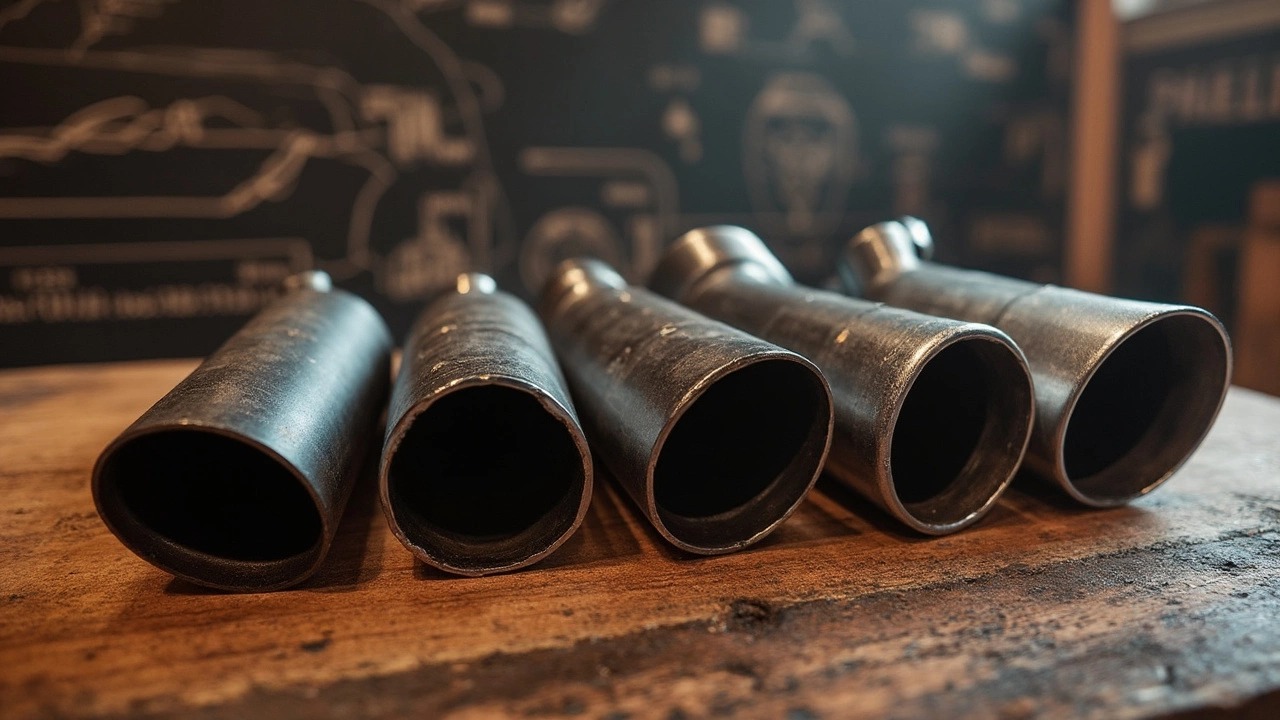 May, 28 2025
May, 28 2025
Most people think exhaust tips are just for looks, but trust me—they play a bigger role in the sound your car makes than you might believe. Ever noticed how a car with those fat chrome tips sounds deeper than a stock sedan? That's not just in your head. The right exhaust tip can make your four-cylinder sound a little meaner or give your V8 a hint more growl.
But before throwing money at the biggest, shiniest tip you find online, it helps to know what actually makes a difference. The shape—rolled edge, straight cut, dual wall—changes how sound waves exit and mix with the air. Materials matter too. Stainless steel has a crisper note, while carbon fiber can muffle things just a bit. And yes, size counts—but not always how you expect.
If you want your car to sound throatier without going full aftermarket exhaust, picking the right tip is a solid first step. Just remember not every tip works the same on every car. That little detail trips up more people than you’d think.
- What Do Exhaust Tips Actually Do?
- Types of Exhaust Tips and Their Sounds
- Does Size or Shape Really Change the Noise?
- Materials That Affect Exhaust Note
- Tips for Getting the Best Sound from Your Exhaust
What Do Exhaust Tips Actually Do?
Pretty much every car on the road has an exhaust tip, but a lot of folks think it’s just a piece of shiny metal slapped on for looks. That’s only part of the story. Exhaust tips sit at the back of your exhaust system and act as the final exit point for all those spent gases. More than that, the shape and size of a tip can play a role in how your car sounds—sometimes a small one, sometimes something you really notice.
Now, let’s get real: if you’ve got a factory stock muffler and you stick on a new tip, you probably aren’t going to turn your Corolla into a V8 Mustang overnight. But a wider or differently cut tip does make minor tweaks to the ‘note’ your car gives off. Want a deeper growl? Go for a larger, rolled-edge style. Want more crackle and bark? Angle-cut or resonated tips help with that.
- Exhaust tips channel gases out more smoothly or, with certain designs, break up the flow for a raspier tone.
- Resonated tips have built-in chambers that slightly amplify or change the exhaust note.
- Dual wall tips will keep cooler on the outside and tend to mellow the sound versus thin single-wall designs.
On its own, the tip won’t make huge changes, but paired with an upgraded muffler, the effect is way more noticeable. It’s kind of like swapping out the speakers in your car stereo—better, but only if the rest of the system can handle it.
| Tip Style | Sound Impact | Common Material |
|---|---|---|
| Rolled Edge | Deeper tone | Stainless Steel |
| Angle Cut | Slightly sharper sound | Chrome, Steel |
| Resonated | Louder, richer | Stainless Steel |
| Double Wall | Smoother, muffled | Chrome |
One exhaust tip isn’t right for everyone, but understanding what actually changes (and what’s total hype) saves you cash—and keeps your car from sounding ridiculous on the street.
Types of Exhaust Tips and Their Sounds
Alright, let's get real—exhaust tips aren't all built the same, and each type cooks up its own flavor of noise. Whether you want aggressive growl or a subtle deep tone, picking the right tip makes a difference. Here's a run-through of the big players in the world of exhaust tips and what they actually sound like on the street.
- Rolled Edge — These tips wrap the metal back toward the tailpipe, rounding the edge. What does that do? It mellows harsh highs, adding a slightly deeper, smoother tone. They're super popular on both factory and aftermarket rides, especially because they don't sound as "raspy."
- Single Wall — As basic as it gets: just one layer of metal. These give a rawer, brighter sound, since there's less mass to soak up vibrations. They're lighter, cheaper, and sometimes a bit more "tinny" on little engines.
- Dual Wall — Two layers of metal, one inside, one outside. Usually heavier, but the sound gets richer and sometimes a touch quieter. These are favorites for bigger V6s and V8s. They just look classy, too, and tend to stand up better to daily driving abuse.
- Angle Cut — If you ever checked out a modern truck or sports sedan, you've probably seen these. The tip is sliced at an angle. Sound-wise? There's just a little more "bite," making idle and revs more pronounced without being annoying.
- Resonated Tips — Now these are made specifically to tweak sound. There's an extra chamber inside or even mesh. A resonated tip can beef up low-end rumble and tone down popping or high-frequency noise. Some call this "fake it 'til you make it" for people who don't want to shell out for a full exhaust.
The chart below compares the practical sound differences people notice on daily drivers.
| Tip Style | Typical Sound Effect | Common Use |
|---|---|---|
| Rolled Edge | Smoother, deeper tone | Sedans, mild performance upgrades |
| Single Wall | Sharpened, higher-pitched | Budget builds, small cars |
| Dual Wall | Richer, sometimes quieter | Trucks, muscle cars |
| Angle Cut | Sharpened, punchier revs | Trucks, newer sedans |
| Resonated | Deeper, less rasp | Luxury cars, for sound tuning |
One big myth: these tips alone won't magically give your car a performance exhaust roar, but they will tweak character and tone. If you want a true night-and-day change, a full exhaust swap is needed. But for small money, the right tip can make those cold starts and red lights feel a bit more fun.

Does Size or Shape Really Change the Noise?
This is one of those car debates that never really dies. Do bigger exhaust tips actually change how your car sounds? Or is it all just hype? Here’s the deal: size and shape can change the sound, but probably not in the way you think. They don’t magically turn a Corolla into a Corvette, but they do tweak the tone and volume a bit.
Here’s what’s really going on. The size of your exhaust tip acts like a megaphone at the tail end of your system. Wider tips usually make the sound a little deeper and sometimes even louder, because they let the sound waves bounce around and blend more before escaping. Smaller or narrow tips keep things more focused and a little sharper sounding. But the size alone won’t make a huge difference if the rest of your exhaust system is stock and quiet.
The shape might surprise you even more. Rolled edge tips, for example, smooth out harshness and give a slightly bassier note. Slant-cut tips seem to throw the sound slightly sideways but don’t add much depth. Dual-wall tips (where it looks like your tip is double-barreled) make the exit sound thicker and meatier—think more "expensive" to the ear. The classic straight-cut is raw and direct, but sometimes a bit raspy, especially on small engines.
- Exhaust tips: Big, rolled or dual-wall tips usually sound the deepest.
- Small or single-wall tips: Cleaner, sharper sound with less bass.
- Slant-cuts: Direct the noise, but don't really change the tone as much.
Let’s break down some common sizes and expected sound effects in a quick table:
| Tip Size | Type/Shape | Common Sound Effect |
|---|---|---|
| 2.5"-3" | Straight cut, single-wall | A bit raspy, not much bass |
| 3.5"+ | Dual-wall, rolled edge | Throatier, deeper, fuller |
| 4"+ | Slant-cut, double-walled | Louder, slight echo effect |
| 2.25" | Turn-down (hidden) | More muted, soft"whoosh" |
If you’re aiming for a noticeable difference, go a bit larger and try dual-wall or rolled edge tips. Just don’t expect miracles if the rest of your system sounds tame—these tips are the final touch, not the main event.
Materials That Affect Exhaust Note
If you want your car to sound a certain way, you can’t just grab any exhaust tip off the shelf and hope for the best. The material you pick changes the tone, volume, and even sharpness. There are three main materials most people see: stainless steel, chrome, and carbon fiber. Each one gives a different vibe and sound.
Stainless steel is the most common and for good reason. It barely rusts, it takes a beating, and it actually helps signal a crisper, sharper exhaust tone. If you want a bit more crackle to go with your rumble, stainless steel is your buddy. For budget builds, mild steel pops up, but honestly, it rusts too easily and doesn't do your sound any favors.
Chrome-plated tips look flashy, but the chrome itself is mostly just there for the shine. Still, the double-walled setup found on lots of chrome tips tends to give the exhaust sound a deeper, slightly muffled tone. A lot of older muscle cars went with chrome for the style and the sound. They shine up easy, but that plating can flake or blue if you get your exhaust temps really high.
If you spot a carbon fiber exhaust tip, you’re looking at the lightweight modern choice. The sound is much more muted. Carbon fiber is a hit for folks who want to keep the look on the exotic side and shave a few grams off the car, but don’t expect a much louder or deeper growl from these.
Here’s a simple breakdown:
| Material | Sound Effect | Durability | Common Use |
|---|---|---|---|
| Stainless Steel | Crisp, sharp | High | Performance cars, daily drivers |
| Chrome-Plated | Deeper, muffled | Medium (plating may flake) | Classic/muscle cars |
| Carbon Fiber | Muted, subtle | High (can scratch) | Sports/exotic cars |
Stainless steel is pretty much the standard if you're after hardcore exhaust tips that last and sound clean. A lot of aftermarket brands—like Borla and MagnaFlow—stick with it because they know it holds up and keeps the sound clear. If all you want is wild style or an understated look without too much noise, then branch out to carbon or chrome.

Tips for Getting the Best Sound from Your Exhaust
If you want your ride to turn heads for the right reasons, getting that exhaust note just right is all about tweaking a few key things. Upgrading your exhaust tip is one piece of the puzzle, but it’s got to match the whole setup to really work.
Here’s what actually moves the needle:
- Exhaust tips with a wider diameter can give deeper tones, especially on engines that already sound decent. But go too big and you’re just making noise, not music. For most cars, a 3- to 4-inch tip is the sweet spot.
- Resonated tips, the kind with built-in tubes or chambers, boost that throaty sound. On turbocharged engines, these can really help dial back some of the whiny notes.
- Single-wall tips will sound sharper than dual-wall versions. The dual-wall ones tend to muffle things a bit, so if you want crisp, go single.
- The material makes a difference too. Stainless steel tips stay loud and bright, while carbon fiber or ceramic-coated tips tone things down.
- Think about the shape. Rolled-edge tips mellow the sound, while straight-cut or angle-cut tips keep it raw and louder. Try to pick a shape that fits your taste, not just your car’s look.
A couple pro tips from the garage: always double-check the tip fits your existing exhaust, otherwise you’ll end up with rattles or leaks, which kill the vibe. If you can, listen to videos of your exact car model with the tip you want. It saves you from dropping cash on something you’ll hate.
Whatever you choose, the best sound comes from matching the tip to your whole exhaust system and your driving style. Find that balance, and you’ll enjoy every cold start and tunnel run way more.